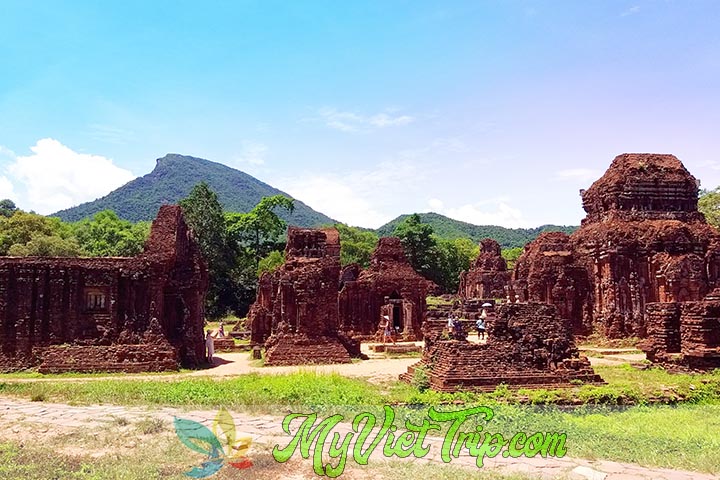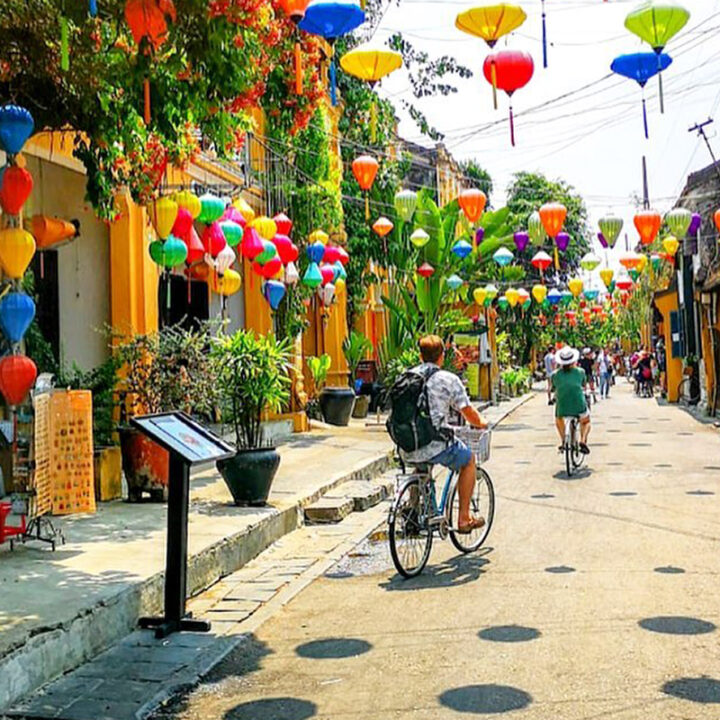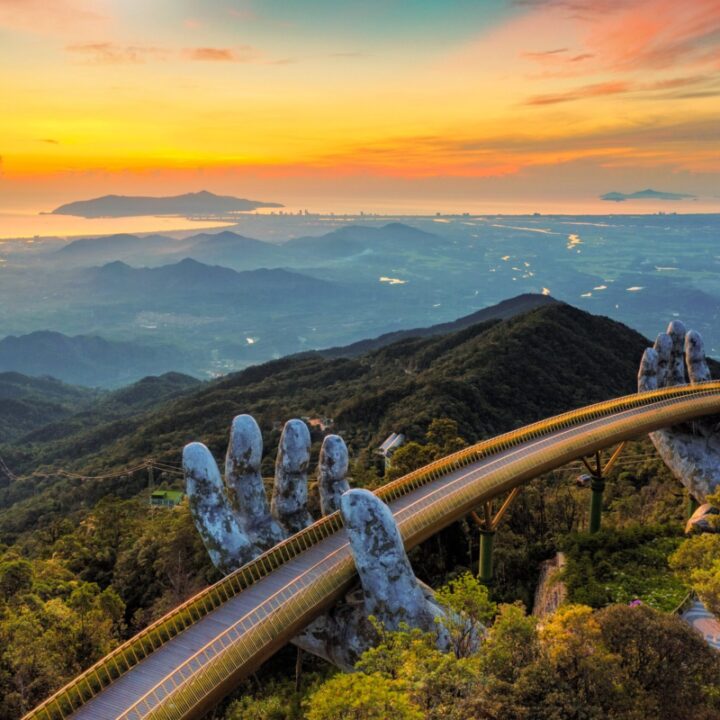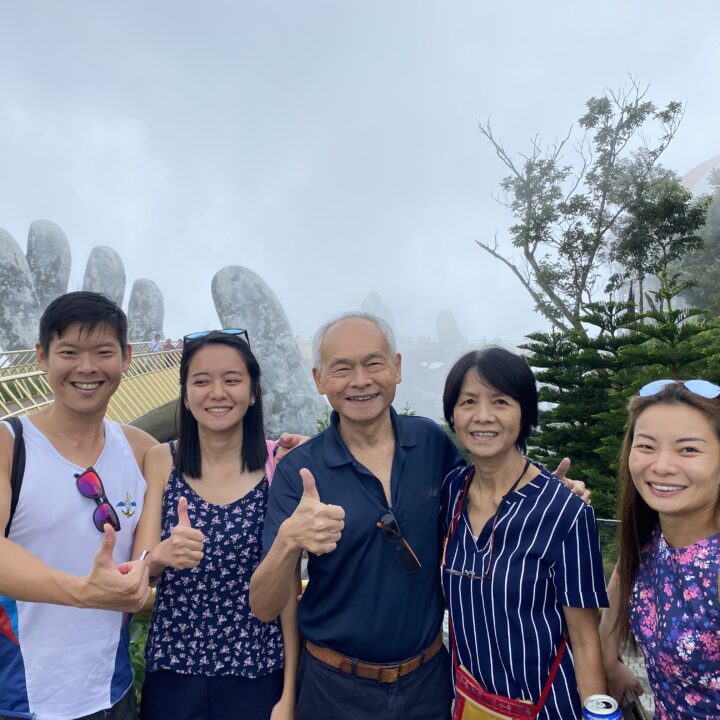Along Central Vietnam, we did not forget the ancient Champa temples scattered on the central strip of land. There is a tower lying on the hills, there is a tower right along the highway, there is another tower hidden in the valley …
Champa Temples ComplexIn fact, they always had a cluster, a complete whole reflecting the Hindu cosmological universe. The ancient conception is that the world is square, surrounded by mountains and the ocean, there is an axis connect to the Sun; they are expressed in Hindu architecture with a square campus, the walls are built high, perpendicular to each other representing the mountain. The works in the overall group of Cham Pa temple towers are usually arranged in a central axis running with the main direction of the works normally open in the East – the direction of the god, of the proliferation and proliferation. In general, the groups of Cham Pa temples and pagodas can be divided into two types:
Triplex layout type Champa Temples – 3 Kalan architecture
Typical for this type are the towers of Chien Dan, Khuong My (Quang Nam), Duong Long, Hung Thanh (Binh Dinh), Hoa Lai (Ninh Thuan …). This tower planning has a subjective architecture consisting of three temples – the towers stand parallel to the North – South axis, facing the East. Depending on the location of each tower, they are called the Southern Kalan, Middle Kalan or Northern Kalan, corresponding to the three deities worshiped: Brahma, Siva and Visnu. That characteristic proves that Champa worshiped all three gods in the early contact with Hinduism. However, in the life of the Cham people at that time also appeared the idea of choosing the god Siva for themselves. Therefore, Siva tower (Middle Kalan) is usually larger than the other two towers. In addition to the subject architecture, there are still sub-architectures around as a whole as mentioned above but most of them are not focused so the durability is not high, most of them were destroyed.
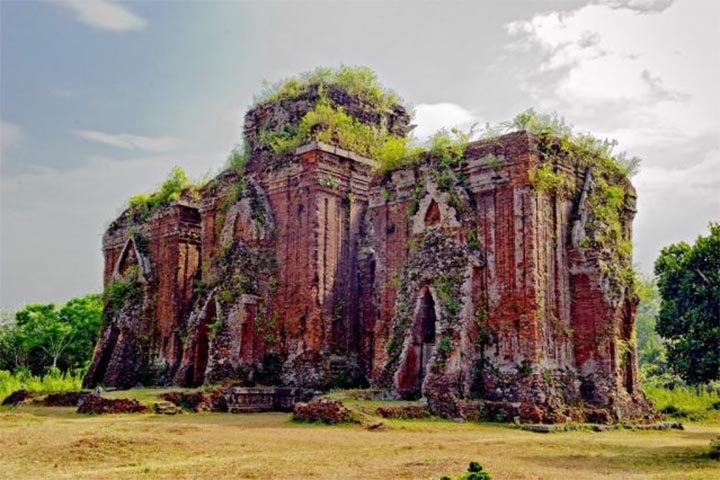
Mono layout type with one central tower (1 Kalan)
Typical for this type are a series of temple towers in My Son Sanctuary (Quang Nam), Poklong Garai (Ninh Thuan), Po Nagar (Khanh Hoa)…
Typical for this type are a series of temple towers in the holy places of My Son (Quang Nam), Poklong Garai (Ninh Thuan), Po Nagar (Khanh Hoa) … The central tower is the place to worship the god Siva, showing now Cham people chose their own national religion – Siva religion. If the Po Nagar tower worships the Godess of Mother, the National mother of the Cham people under the influence of Siva religion shows the mixture between indigenous beliefs and Hinduism, on the contrary, the Yang Prong tower (Easup – Dak Lak) ) worshiped Siva in the form of Mukhalinga, proving the close relationship between the Cham people and the tribes living on Highlands.
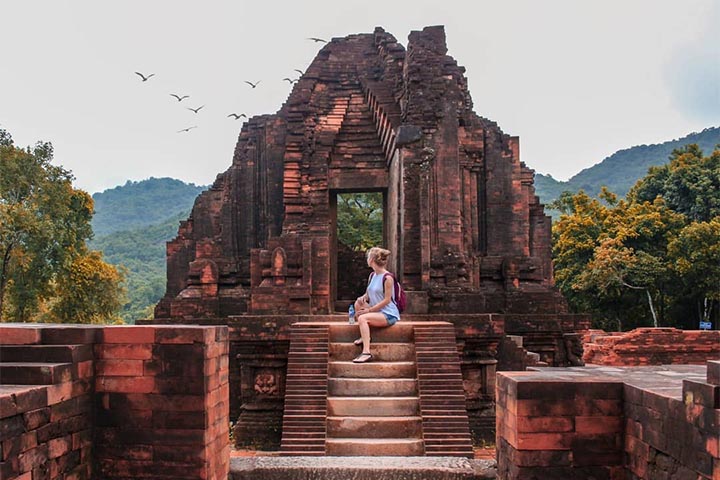
Architectural characteristics of Champa Temples
Except for a few temple groups, such as Bang An tower(Dien Ban-Quang Nam), Hung Thanh Tower (Quy Nhon-Binh Dinh City) have North Indian architectural features, the majority of Cham temples in our country have South Indian style. In this type of composition, the subject architecture (Kalan) is always placed in the center of the composition with the open East door. The Subarchitecture section consists of secondary worship towers and sub-towers around: Fire tower (Kosagrha), Gate tower (Gopura), Assembly Hall (The Meditation Room) (Mandapa), Stela Tower (Po Sha), wall covers… Each of these works has its own unique architectures or separated functions… However, most of the temple groups have been degraded and collapsed, many auxiliary structures have only foundations.
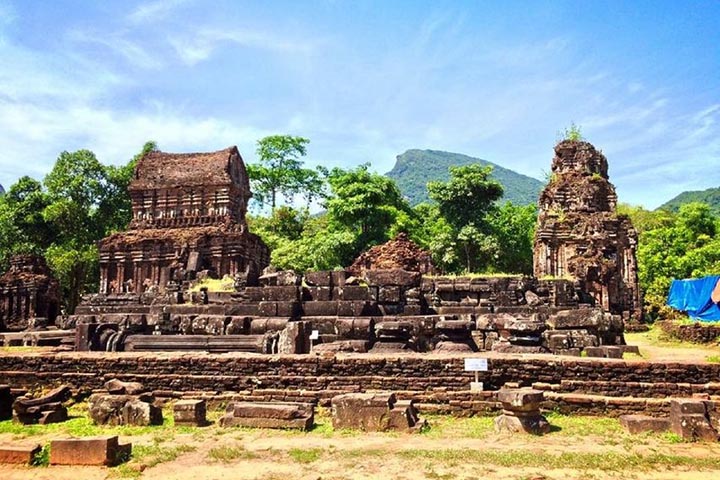
Kalan – The main Champa Temples
Located in the center of a group of temples, with a square base, four directions with four doors, but only one door opens in the main direction, the remaining directions are fake doors, protruding. on the wall. A Kalan temple usually has three basic parts that contain very deep philosophical meanings: The base of the tower (Jagati) symbolizes the mundane world. The body (Bhuwarloke) symbolizes the spiritual world, where people have purified themselves and washed away all the dust to come closer to their ancestors. The roof of the tower (Swarloka) symbolizes the divine world, usually with 3 floors and a closed top. Each floor is full of architectural features of a temple with fake doors, pillars, roof borders… but it is reduced and simplified
Inside Kalan, in the center lies a sandstone pedestal, surrounded by a narrow path that looks like a path in Buddhist architecture … The Pedestal is the image of a God or the Linga – Yoni, including 3 parts: the plinth, the Yoni pedestal (whose faucet always turns to the North because according to the Indian philosophy, the North represents for water and is also the direction of the God of wealth – Kuvera); Linga pillars (a major symbol of the God Siva). Some pedestals (such as My Son E1 pedestal) have been carved very vividly, showing ingenious talents of ancient artisans; on the pedestal is animations showing the life of Brahmin monks; they are contemplating under trees, praying, playing music, making medicine, preaching. On the Linga sometimes people can see the God Siva or the king they worship (Mukkalinga), like Linga in Poklong Garai tower (Ninh Thuan).
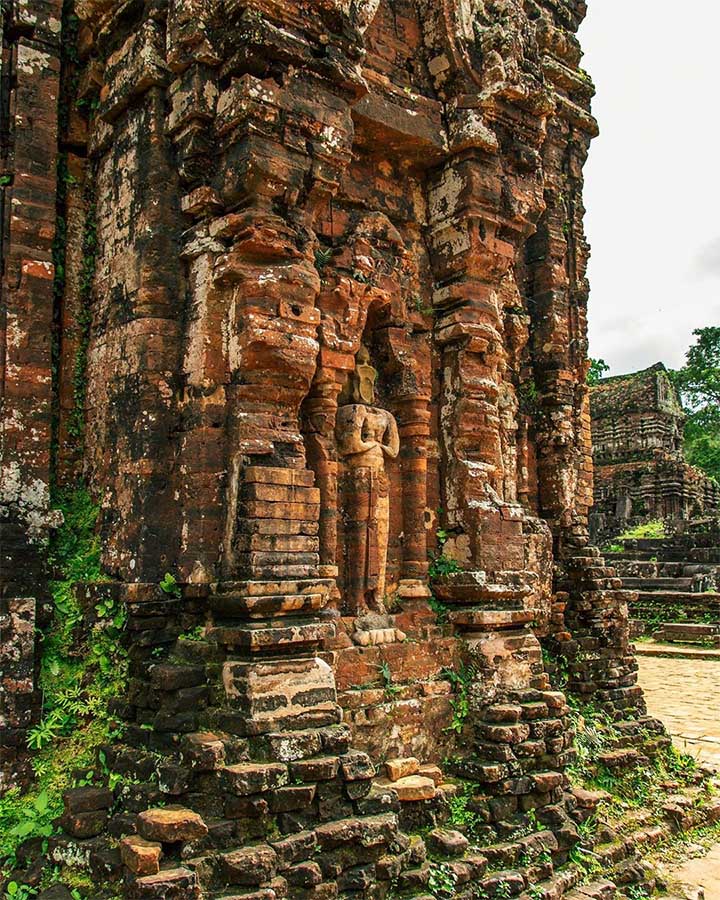
Gopura – The Gate Tower
This building is always located on the wall, in front of Kalan and also has an interior space including a square room but completely empty, the lobby in the two East – West branches becomes a narrow and very short corridor. Gopura also has a dome that shrinks from the bottom up. The height of the base of the tower varies depending on whether the foot is inside or outside of the wall of the group. The foot of the outer wall is usually larger than the inner, which also means the inner courtyard will be higher than the outer courtyard and worshipers will be led to the ascending direction. Gopura’s body and roof have models and structures like the Kalan tower: also fake doors, arches, tangent pillars, also floors, corner decorative frills, door frames and stone pillars … but the scale and size are smaller.
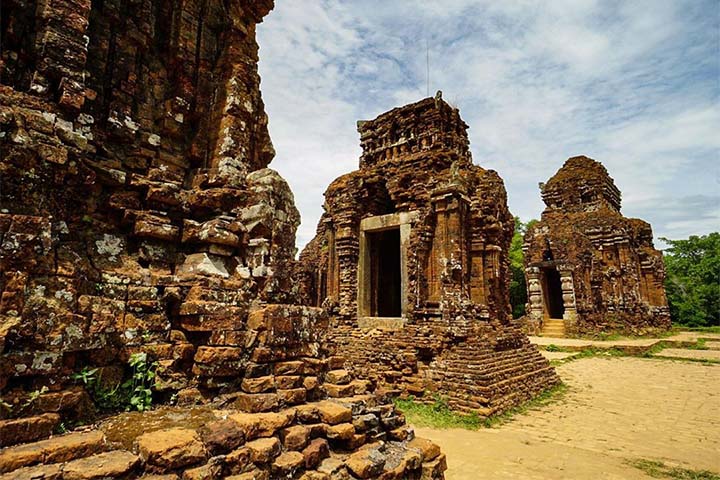
The Assembly Hall – Mandapa
Located on a coaxial axis with Kalan and Gopura, Mandapa is the place where people prepare sacrifices before the ceremony at the main temple. Mandapa is an architecture with a rectangular surface, with long edge often many times longer than the short edge, the interior is wide and airy, two doors are open in two directions – East – West. On the North and South wall, there are many windows. All of the existing Mandapas cannot keep their tiled roofs, but the wall can still see traces of the tiled roofing structure.
Most Mandapas are outside the walls but sometimes due to limited space, they have built it between Kalan and Gopura (H2 – My Son, Poklong Garai.) Mandapa Po Nagar is a quite special form with bricks pillars supporting tiled roof, without walls and built on another ground lower than the ground of the whole group.
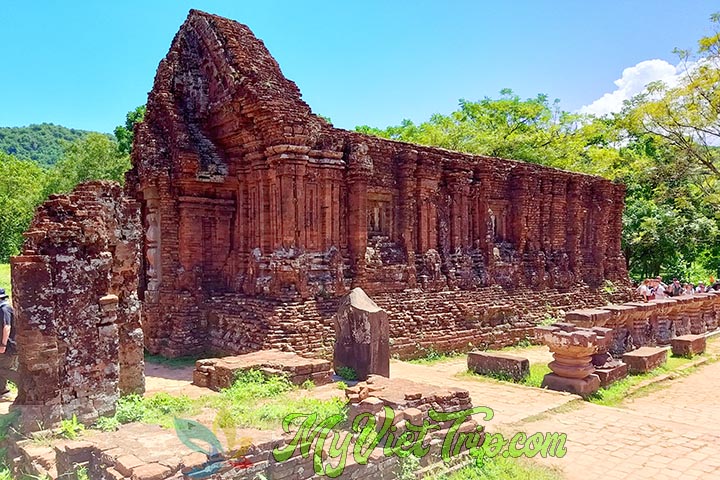
The Fire tower – Kosagrha
Kosagrha is the name of a special architecture in a group of temples – Champa tower. This work is also Vietnamized by many different names: the South house, boat-shaped roof house, warehouse or fire tower, worshiping fire god tower (Ahni)… Kosagrha is always located inside the surrounding walls, in the location of the southeast corner of the wall (so for traditional groups of temples, the door is always open to the east, Kosagrha will be in front of Kalan and with some special groups of temples, this building is located behind Kalan). This architecture has a rectangular surface, spacious interior, with walls dividing into 2 rooms. Doors are always opened to the North (in the direction of the God of wealth – Kuvera) but often slightly westward, not in the middle of the wall. The East-West wall has two windows with bars made of stone; South wall surface is built, decorated with pillars. Kosaghra has only two floors: with the boat-shaped roof facing up, it makes it easy to get the attention of the whole temples group. The base is decorated with small atrial leaves at the transitional position of the pillars.
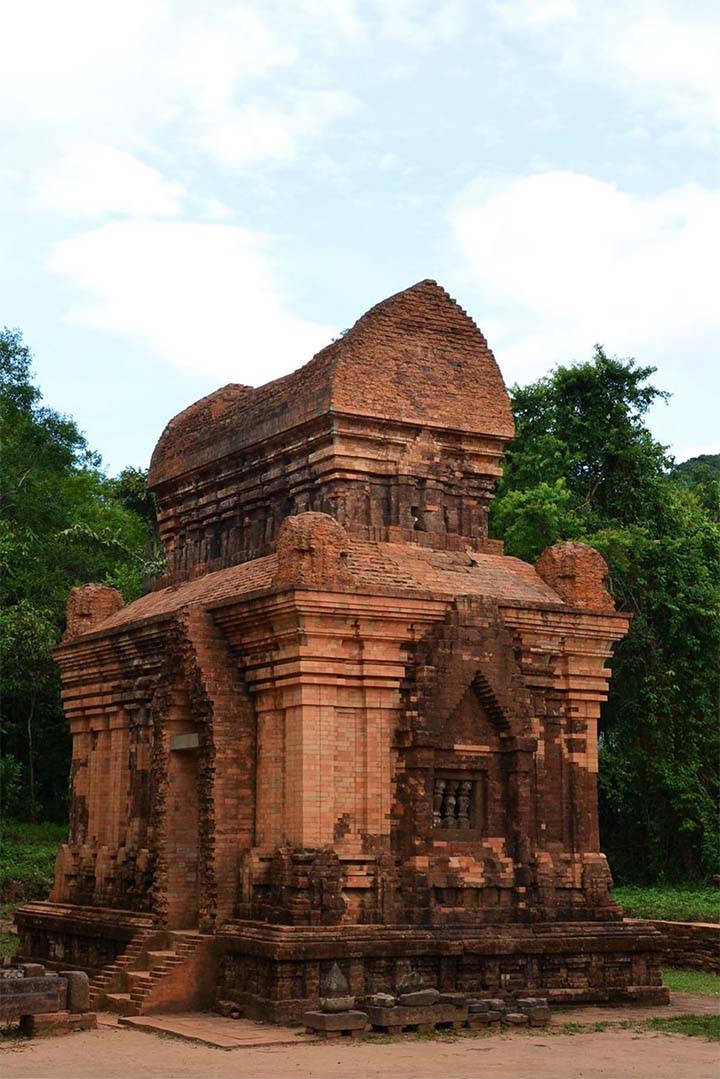
Kosaghra’s windows also have arched arches, carved inside a certain theme. The most typical is the sight of two elephants fighting each other on the arch of the East-West wall of Kosaghra My Son B5. This pair of elephants is related to the goddess Gajalaskmi. According to the Sanskrit language, Gaja is the elephant and Laskmi is the wife of Visnu and is reasonable during this period that Champa temples were also involved in the worship of Visnu in this country’s mixed religious picture …
In addition, many temple groups also have some other auxiliary structures, such as the Stela tower (Posah), B6 tower (in group B – My Son relics) containing a shallow tank containing Holy water; towers from A2 to A7 (in group A – My Son relics area) together with the main gate A1 worship the direction gods.
Thus, it can be seen that in the master plan, the connection between Hindu thought and indigenous beliefs comes together to find a harmonious solution in almost every aspect: size, layout, method. direction, angle … The architecture of Cham Pa temple is a place to recognize and clearly express the profound philosophies of Hindu art after penetrating through the talented hands of ancient Cham artisans.
In addition to the architectural features, Hindu gods and relics have become a rich source of sculptures, decorations on the architecture and worship items in ChamPa temples. However, due to the devotion, the soul and the talented hands, the images associated with Indian architecture and religion have been localized to have a very specific layout, lines, and scale of expression, simple but still vivid and meaningful.

